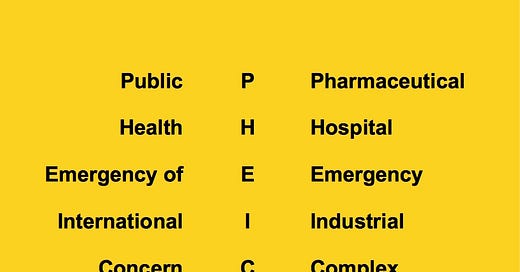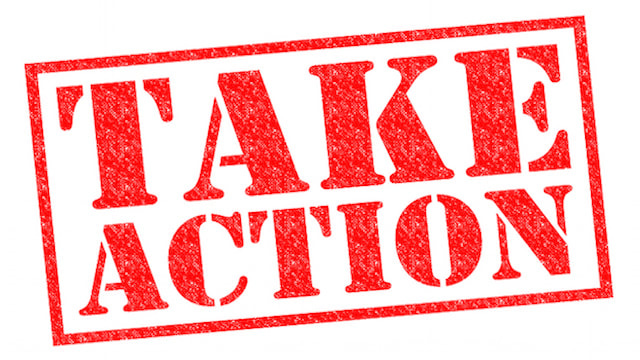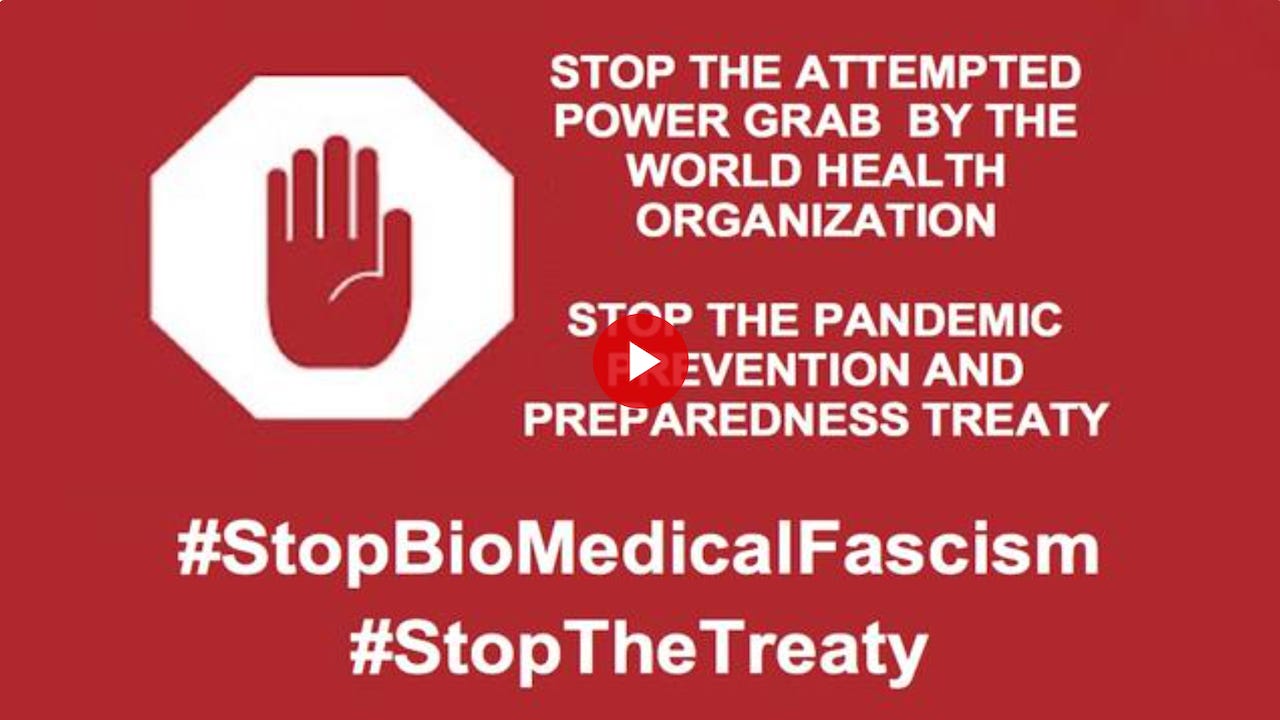The Pharmaceutical Hospital Emergency Industrial Complex (PHEIC)
Big Pharma wants to conclude the "Pandemic Agreement" before the end of 2024 in order to finance a dramatic expansion of their business model in low and middle income nations.
Please watch the video below:
https://rumble.com/v5ipzat-unrestricted-warfare-ep.-176-who-lockdowns-with-james-roguski.html
I STRONGLY ENCOURAGE YOU to take the time to express your personal opinion regarding the proposed “Pandemic Agreement.”
Record your own video, post it online (on the video platform of your choice) and then SHARE THE LINK TO YOUR VIDEO in the comment section below so that I can add YOUR video to an upcoming article featuring people who have voiced their opposition to the WHO’s “Pandemic Agreement.”
Despite the fact that they have until the 78th World Health Assembly at the end of May 2025 to conclude the negotiations, the “Bureau” of the Intergovernmental Negotiating Body (INB) has been pushing to reach “consensus” on a Pandemic Agreement “Lite” by November 11, 2024 in order to schedule a special session of the World Health Assembly in December 2024 at which they hope to adopt the “Pandemic Agreement.”
Some reasons to oppose the "Pandemic Agreement."
Corporate representatives and a vast array of special interest lobbyists have been allowed to participate in these negotiations, but there has effectively been no public discussion or debate. We the people neither want nor need a "Pandemic Agreement," and certainly not one that fails to take our input into account. CLICK HERE AND HERE FOR A DETAILED LIST OF SPECIAL INTEREST GROUPS INVOLVED WITH THESE NEGOTIATIONS.
It seems that the "lessons learned" by the negotiators completely ignore the harms that were caused by lockdowns, mask and "vaccine" mandates as well as the adverse health effects caused by the masks, PCR swabs, “approved therapeutics” and the "vaccines" themselves. CLICK HERE, HERE AND HERE to learn more.
The current attempts to rush through an incomplete Pandemic Agreement "Lite," leaving many of the controversial issues to be decided later is unacceptable. Kicking the can down the road in order to rush through an agreement before the end of 2024 is obviously politically motivated. CLICK HERE to learn more.
Rather than strengthen and globalize liability protection for pharmaceutical companies, they must be held accountable for the harm that their products continue to inflict upon billions of people worldwide. See Articles 13.6 and 13bis (8) HERE
In its current form, the proposed "Pandemic Agreement" fails to adequately address the issue of gain-of-function research and the proposed Pathogen Access and Benefits Sharing System (PABS) would effectively monetize and incentivize the search for "pathogens with pandemic potential." This will not make the world safer, but will have exactly the opposite effect. See Article 12 HERE
The proposed "Pandemic Agreement" is not about health. It is merely a redistribution of wealth under the guise of "equity." In a world were the vast majority of people do NOT die from infectious diseases, the "Pandemic Agreement" amounts to a massive misallocation of funds, resources and energy. The open-ended “coordinated financing mechanism” could redirect billions of dollars towards the manufacturing of "pandemic-related products" that actually cause more harm than good. See Article 20 HERE
The inclusion of cell-based and gene-based therapies in the category of pandemic-related health products is absolutely inappropriate. It is unethical to experiment with genetic manipulation under the guise of emergency response. See Article 1(d) HERE
The World Health Organization should not be given the authority to oversee and/or operate a Global Supply Chain and Logistics Network to control access to pandemic-related products. See Article 13 HERE
Setting up a new bureaucracy (the Conference of the Parties) consisting of unelected, unaccountable and largely unknown bureaucrats will surely lead to more waste and corruption long before it helps to prevent, prepare for, or respond to future "pandemics." See Articles 21-37 HERE
Despite the fact that the word "pandemic" appears in the latest version of the document 244 times, the term "pandemic" is not defined in the proposed agreement. The failure to define the terms “pandemic” and “vaccine,” as well as many other terms, is absolutely unacceptable. See Article 1 HERE
Please watch the very first video that I recorded on this topic in March 2022:
https://www.bitchute.com/video/jelwAdc9Myjf/
Below are a few sample videos to give you ideas for recording your own video:
https://www.bitchute.com/video/68noiys4ufyP/
https://www.bitchute.com/video/kyQa5QLLJqhi/
The latest official version of the “Pandemic Agreement” is available HERE.
An updated, unofficial version is available HERE.
Some important excerpts are below:
Chapter I.
Introduction
Article 1.
Use of terms
For the purposes of the WHO Pandemic Agreement:
(a) “manufacturer” means public or private entities that develop and[/or (DEL)/(RETAIN)] produce pandemic-related health products [[including] (DEL)] [for sale] (DEL)];
(d) [[“pandemic-related health products” [means [safe, effective, quality and affordable] health products, including medicines, vaccines, medical devices including diagnostics, personal protective equipment, decontamination products, assistive products, antidotes, cell- and gene based therapies, and other health technologies that are needed to respond to public health emergencies of international concern, including pandemic emergencies;] [means the safe, effective, quality and affordable products that are needed for pandemic prevention, preparedness and response, [which may include, without limitation (DEL)/(RETAIN)/including], diagnostics, therapeutics, vaccines and personal protective equipment [and ancillary supplies [[and other health technologies] (DEL)];]]
Article 2.
Objective
1. The objective of the WHO Pandemic Agreement, guided by equity and the principles further set forth herein, is to prevent, prepare for and respond to pandemics.
2. In furtherance of this objective, the provisions of the WHO Pandemic Agreement apply both during and between pandemics, unless otherwise specified.
Article 3.
Principles [and approaches] (DEL)]
To achieve the objective of the WHO Pandemic Agreement and to implement its provisions, the Parties shall be guided, inter alia, by the following [principles (DEL)] [and approaches] (DEL)]:
4. Equity as a goal [, principle] and outcome of pandemic prevention, preparedness and response, striving for the absence of unfair, avoidable or remediable differences among and between individuals, communities and countries;
Article 10.
Sustainable and geographically diversified local production
1. The Parties shall take measures, as appropriate, to achieve more equitable geographical distribution and rapid scale-up of the global production of pandemic-related health products and increase sustainable, timely and equitable access to such products, as well as reduce the potential gap between supply and demand during pandemic emergencies, including through the measures provided in Articles 11 and 13.
2. The Parties, in collaboration with WHO and other relevant organizations, shall, as appropriate and subject to national and/or domestic law:
(a) take measures, to provide support, and/or strengthen existing or newly created production facilities of relevant health products, at national and regional levels, particularly in developing countries, with a view to promoting the sustainability of such geographically diversified production facilities, including through supporting and/ or facilitating skills development, capacity-building and other initiatives for production facilities;
(b) facilitate the continuous and sustainable operations of local and regional manufacturers, especially of developing countries, including through promoting transparency of relevant information on pandemic-related health products and raw materials across the value chain that is not subject to protection under relevant domestic and international law;
(c) actively support, relevant WHO technology, skills and knowledge transfer and local production programmes, including those referenced in Article 11, and other relevant programmes, to facilitate sustainable, strategically and geographically distributed production of pandemic related health produucts, particularly in developing countries;
(d) endeavour to promote and/or incentivize public and private sector investments, purchasing arrangements, and partnerships, including public-private partnerships, aimed at creating or expanding manufacturing facilities or capacities for pandemic-related health products, including facilities with a regional operational scope in developing countries;
(e) encourage international organizations and other relevant organizations to establish arrangements, including appropriate long-term contracts for pandemic-related health products, including through procurement from facilities referenced under paragraph 2(a) and pursuant to the objectives of Article 13, especially those produced by local and/or regional manufacturers in developing countries; and
(f) during pandemic emergencies, in cases where the capacity of facilities referred to above does not meet demand, take measures to identify and contract with manufacturers with the aim of rapidly scaling up the production of pandemic-related health products.
3. WHO shall, upon request of the Conference of the Parties, provide assistance to the facilities referenced under paragraph 2 above, including, as appropriate, with respect to training, capacity building, and timely support for development and production of pandemic-related products, especially in developing countries, with the aim to achieve geographically diversified production.
Article 13.
Supply chain and logistics
1. The Global Supply Chain and Logistics Network (the GSCL Network) is hereby established to enhance, facilitate, and work to remove barriers to, equitable, timely and affordable [and unhindered] access to pandemic-related health products, as well as to enable access to such products in humanitarian settings, in accordance with international law. The Global Supply Chain and Logistics Network shall be developed, coordinated and convened by WHO in full consultation with the Parties, WHO Member States, and in partnership with relevant stakeholders, under the oversight of the Conference of the Parties. The Parties shall prioritize, as appropriate, sharing pandemic-related health products through the Global Supply Chain and Logistics Network for equitable allocation based on public health risk and need, in particular during pandemic emergencies.
2. The Conference of the Parties shall, at its first meeting, define [by consensus] the structure, functions and modalities of the Global Supply Chain and Logistics Network, with the aim of ensuring the following:
(a) collaboration among the Parties and other relevant stakeholders during and between pandemic emergencies; (the issues of defining different relevant stakeholders might need further work)
(b) the functions of the Global Supply Chain and Logistics Network are discharged by the organizations best placed to perform them;
(c) consideration of the needs of developing countries and the needs of [persons in vulnerable situations] [those in vulnerable situations] [vulnerable populations], including those in fragile and humanitarian settings;
(d) the equitable and timely allocation of pandemic-related health products, based on public health risk and need, including through procurement from the facilities referenced under Article 10; and (e) accountability, transparency, and inclusiveness in the functioning and governance of the Global Supply Chain and Logistics Network allowing for equitable representation of the WHO Regions.
Article 13.3 is displayed as subparagraphs as suggested by the EU:
3. The functions of the Global Supply Chain and Logistics Network shall include, inter alia, subject to further decision making by the Conference of the Parties:
a) identification of pandemic-related health products and relevant raw material sources including cosourcing or co-allocation;
b) identification of barriers to their access;
c) estimation of supply and demand;
d) facilitation of procurement during PHEIC and pandemic emergencies including from facilities referenced under Article 10;
e) coordination of relevant procurement agencies within the Global Supply Chain and Logistics Network and pre-pandemic preparatory work;
f) promotion of transparency across the value chain;
g) collaboration on stockpiling both during pandemic emergencies and inter-pandemic periods;
h) facilitation of, and working to remove barriers to equitable [and unimpeded] access, including [through] allocation, distribution, delivery, and assistance with utilization, including for products provided to the PABS system, during a PHEIC and a pandemic emergency.
4. The Conference of the Parties shall periodically review the functions and operations of the Global Supply Chain and Logistics Network, including the support provided by the Parties, WHO Member States and relevant stakeholders, during and between pandemic emergencies and may provide further guidance related to its operations, should the need arise as relevant.
Note: The Bureau would consider the issue of what exactly the three consecutive events in 1, 2 and 4 (defining the structure of the Global Supply Chain and Logistics Network, first COP, and periodical review) would entail in terms of functions.
5. During a pandemic emergency and PHEIC, the rapid and unimpeded access of humanitarian relief personnel, their means of transport, supplies and equipment and their access to pandemic-related health products shall be allowed and facilitated in accordance with national and international law, and the principles contained in Article 3 of this Agreement. [including international humanitarian law] [and principles] [the Charter of the United Nations.] [and its purposes and principles, [with respect for sovereignty, and the principle of sovereign equality].
6. [The Global Supply Chain and Logistics Network may consider developing recommendations, for the consideration of the Conference of the Parties, [for a possible no-fault compensation mechanism] [multilateral mechanism for liability risk management] for novel pandemic vaccines allocated through the Global Supply Chain and Logistics Network, with particular regard for persons in humanitarian settings.] 7. WHO, as the convener of the Global Supply Chain and Logistics Network, shall report to the Conference of the Parties, at intervals to be determined by the Conference of the Parties.
Article 20.
Sustainable financing
1. The Parties shall strengthen sustainable and predictable financing to the extent feasible, in an inclusive and transparent manner, for implementation of this Agreement and the International Health Regulations (2005).
2. In this regard, each Party, subject to national and/or domestic law and available resources, shall:
(a) maintain or increase domestic funding, as necessary, for pandemic prevention, preparedness and response;
(b) [to the extent possible,] mobilize additional financial resources to support Parties, in particular developing country Parties, in the implementation of the WHO Pandemic Agreement, including through grants and concessional loans;
(c) promote, as appropriate, within relevant bilateral, regional and/or multilateral funding mechanisms, innovative financing measures, including transparent financial reprogramming plans for pandemic prevention, preparedness and response, especially for developing country Parties experiencing fiscal constraints; and
(d) encourage inclusive and accountable governance and operating models of existing financing entities to minimize the burden on countries, offer improved efficiency and coherence at scale, enhance transparency and be responsive to the needs and national priorities of developing countries.
[2.bis The Parties shall refrain from taking any measures that may adversely affect the sustainable and predictable financing of other Parties for the purposes of this Agreement. (DEL / RETAIN)]
3. A Coordinating Financial Mechanism (the Mechanism) [is hereby established] to:
(a) promote sustainable financing for the implementation of this Agreement and the IHR to support strengthening and expanding capacities for pandemic prevention, preparedness and response; and
(b) contribute to the [availability of] surge financing response necessary [for day zero], particularly in developing country Parties.
Note: ‘is hereby established’ and ‘for day zero’ – questioned by one Member State
3 Bis. The Mechanism shall, inter alia:
(a) conduct relevant needs and gaps analyses to support strategic decision-making and develop every five years a financial and implementation strategy for the Pandemic Agreement, and submit it to the Conference of the Parties for its consideration; Note: Paragraph not accepted by one Member State
(b) promote harmonization, coherence and coordination for financing pandemic prevention, preparedness and response and International Health Regulations (2005)-related capacities;
(c) identify all sources of financing that are available to serve the purposes of supporting the implementation of this Agreement and the International Health Regulations (2005), and maintain a dashboard of such instruments and related information and the funds allocated to countries from such instruments;
(d) provide advice and support, upon request, to Parties in identifying and applying for financial resources for strengthening pandemic prevention, preparedness and response; and
(e) leverage voluntary monetary contributions for organizations and other entities supporting pandemic prevention, preparedness and response, free from conflicts of interest, from relevant stakeholders, in particular those active in sectors that benefit from international work to strengthen pandemic prevention, preparedness and response.
4. The Mechanism shall function under the authority and guidance of the Conference of the Parties and be accountable to it. Its operation may be supported by one or more international entities to be selected by the Conference of the Parties. The Conference of the Parties shall adopt [, by consensus,] terms of reference for the Mechanism and modalities for its operationalization and governance, within 12 months after the entry into force of the WHO Pandemic Agreement, and may adopt necessary working arrangements with other international [financial] entities.
5. The Conference of the Parties shall take appropriate measures to give effect to this Article, including the possibility of exploring, additional financial resources to support the implementation of this Agreement [through new or existing funds].
6. The Conference of the Parties shall periodically consider, as appropriate, the financial and implementation strategy for the Pandemic Agreement referred to in paragraph 3(a) of this Article. The Parties shall endeavour to align with it, as appropriate, when providing external financial support for the strengthening of pandemic prevention, preparedness and response.
I wrote about this nearly two years ago…
James Roguski
310-619-3055
JamesRoguski.substack.com/archive
All content is free to all readers.
All support is deeply appreciated.


























Phil Howard
Hi James, thank you for your work. Another old guy here from Canada and not up to speed with the technology BUT totally up to speed with many substacks including yours. Aggressively active here and un-jabbed and will remain that way, so I agree with Warren Scott Human (thread below). Here in Canada you can't believe this 'shit-show' we have lived thru. We'll continue supporting you and what you do!
FUCK NO!